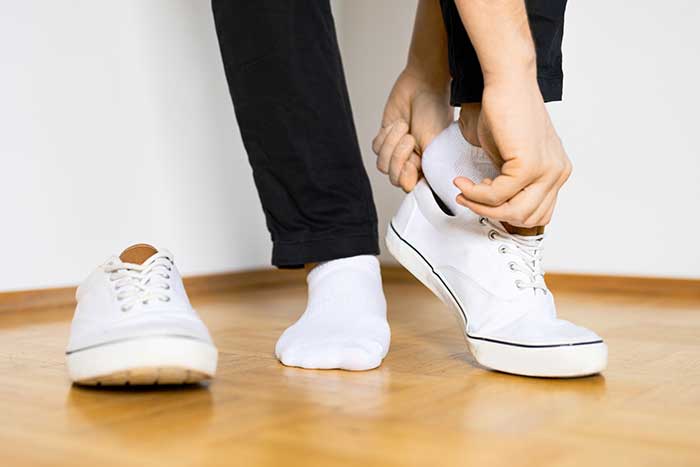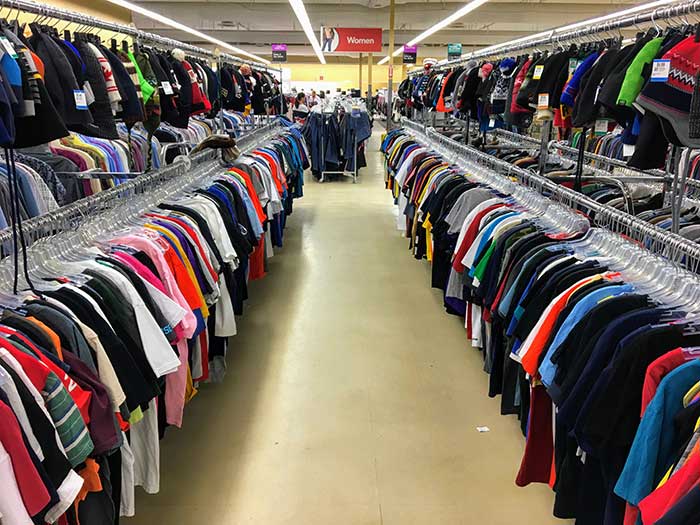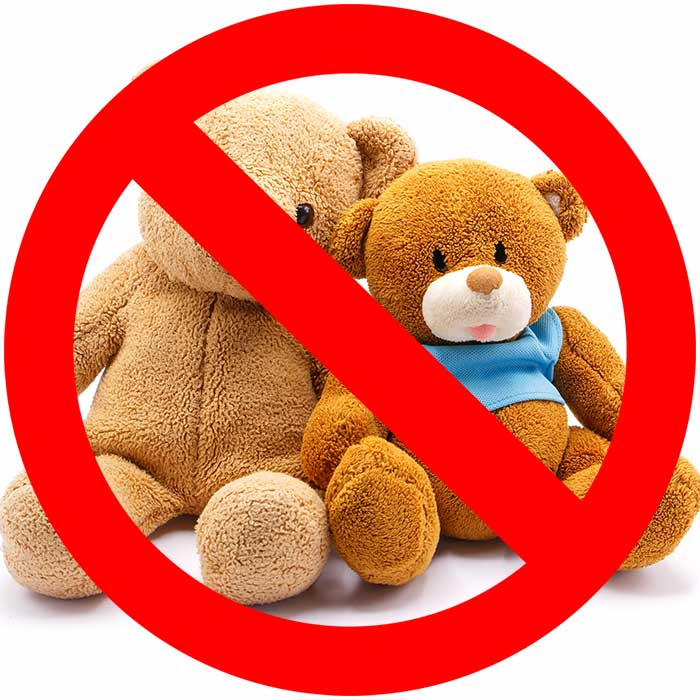Shutterstock
From our friends at HeyPumpkin:
If there is one thing I love, it’s buying things secondhand.
I’ve been hitting thrift shops and antique stores since I was a kid. It takes plenty of patience and self-control, but the payoff when you find that perfect, one-of-a-kind item… there’s nothing like it.
Over the years, plenty of people have asked me how I get so lucky, or how I manage to find amazing designer pieces at a fraction of a cost. Sure, I have years of experience, and I’ve stepped foot in more secondhand stores than I could ever count. But you don’t have to be a veteran thrift store shopper to find the good stuff.
All you need is a little patience, and some expert tips. You’ll be a thrift store pro in no time!
Skip the big city or rich neighborhoods, and go a little further out instead. I have found more amazing pieces in small towns than anywhere else. But why is that?
First of all, thrift stores in small towns often don’t get enough donations to stock the store. With big companies like Goodwill, they ship in inventory from large cities that get tons of donations.
But more importantly, there’s less foot traffic, so the shops are less picked over. That means that small town secondhand shops are getting the same good stuff being donated in big cities, but there are less people coming in to shop for those items. If that’s not a recipe for thrift store success, I don’t know what is!

What you wear to the thrift store can sometimes be just as important as the thrift store you visit.
Many secondhand shops don’t have fitting rooms like regular clothing stores, and many of them do not offer refunds (although some will give you store credit if you return items within a limited time frame). If you are shopping for clothing, you will do best to wear something you can easily slip clothing over to try on. This means no bulky clothing.
If you’re looking for something specific, you may want to rethink your choice of shoes. For instance, if you are shopping for a wedding dress, it might be a good idea to wear heels so you can see exactly how the hem falls. However, if you are shopping for furniture, you will want to wear comfortable sneakers for when you have to lug heavy pieces out of the store!
Thrift stores and consignment shops have set schedules for when they restock, and when they put items or certain colors of tags on sale. Knowing this schedule can mean saving money, but it can also mean finding the best items.
Restocking usually happens in the middle of the week, when the store is less busy. It may not work for everyone, but if you can be there right after the store is restocked, you stand a much better chance of getting lucky with your finds. If you wait until Saturdays, the store will be much busier and already picked over.
Much like with traditional retail stores, shopping off-season can be a great way to save some cash when shopping at secondhand stores. The best deals are always on clothes that are not currently in high demand.
Shop for sundresses and sandals during colder months, and check out coats and boots in the middle of the summer. Not only will you find better prices, you will also have more items to choose from.

When thrifting, it is important to give yourself enough time. Unlike with shopping at stores stocked with multiples of every item, shopping at a thrift store means digging and hunting.
The best thing you can do to increase your chances of finding those amazing pieces? Give yourself time.
Sure, some of us have found some cool stuff the second we walked through the front door. But most of the time, those amazing finds come from hunting through an entire store. You won’t be able to discover gems by just glancing at full racks. You’ll need plenty of time to shuffle through all those racks of clothing to find that perfect shirt. I don’t even want to admit how much time it takes to try on pair after pair of jeans to find the ones that fit.
It’s always a good idea to review your closet before heading to the thrift store. By donating items you no longer wear, you’ll make space for your new treasures. Some thrift stores will even give you a coupon when you drop off donations, saving you more money.
This is also a great way to remember what you already have, and what you don’t need more of. It’s also a great time to take photos of items you already have, so you can find other pieces that you can pair with them.
You can find some great deals on appliances and electronics at secondhand shops, and even some vintage things that you can no longer buy new easily or inexpensively — a local thrift store came to the rescue when I needed a VCR to revisit some old VHS tapes! But before you buy, you need to verify that it works.
Most thrift stores will have outlets available for testing items with cords. However, it’s a good idea to keep a small stash of different sized batteries on hand in the off-chance you find something battery-operated that you can’t live without.

While I encourage buying secondhand for plenty of things, there are some things that you should never purchase at thrift, consignment, or antique stores. These pre-owned items could be unsanitary, unsafe, or downright dangerous.
Helmets: Most experts recommend replacing helmets every three to five years in order to keep up with safety standards. How old is that helmet at the thrift store? Besides, helmets lose their ability to protect you (literally their sole purpose!) once they receive impact. You have no idea how much wear and tear a helmet has endured before it ended up at the thrift store.
Stuffed Animals: Sure, those plushies are adorable, but they could also be harboring things you really don’t want to bring home. While fleas and bed bugs aren’t necessarily attracted to stuffed animals, the materials make it easy for them to stay hidden and hitch a ride to your house.
Pet Furniture: Plush pet beds, blankets, toys, and more can also fall victim to hidden fleas, like stuffed animals. It’s also worth noting that you have no idea what the previous pets were up to on secondhand pet furniture, and there could be lingering smells that we don’t detect but could upset your pet, like pheromones.
Mattresses and Upholstered Headboards: I promise I’m almost done talking about bed bug and flea infestations, but I have to warn you against mattresses and upholstered headboards! We all know that bed bugs like to hunker down in mattresses, but we rarely think of upholstered headboards. If you see a headboard you just can’t live without, go ahead and treat it for bed bugs out of extreme caution before bringing it inside your home.
Car Seats: Car seats are supposed to be replaced after an accident, but you have no way of knowing if the previous owner followed that rule — or, if the car seat is at the thrift store because they followed it. You also have no idea if it has been recalled, how old it is, or if it is up to current safety standards.
Cribs: Much like car seats and other child safety items, regulations are continuously changing and products are becoming safer. That means that outdated cribs and other things could be well past their expiration and don’t meet the current safety criteria, or have been recalled. You also have no idea where it came from, and if it met any safety criteria to begin with.
Chipping Paint: If you’ve got your eye on a vintage dresser or even an old door, be cautious of items with chipping paint. You don’t have to avoid buying these items, but you do need to be aware that the paint could contain lead. You can pick up a lead paint test for cheap to make sure you’re safe.
Makeup and Perfumes: You’re not likely to find used makeup in a thrift store, but in the off chance that you do, don’t buy it. Using someone else’s makeup can lead to bacteria or skin infections. However, even with unopened cosmetics, you have no way of knowing how old it is or what might be in it. Old makeup can contain dangerous substances, like phthalates, lead, and asbestos.
Underwear and Swimsuits: Just… don’t do it. I feel like this one is pretty obvious.
Hopefully these tips will help you with your next trip to the thrift store! There’s nothing like the thrill of the hunt, and the joy of finding that one amazing item.
Just remember to have patience. There are some days where you may discover tons of cool finds, while other days you may leave empty handed. It happens to the best of us!